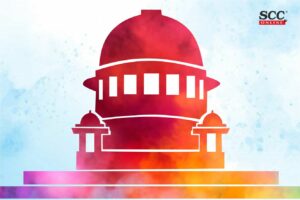Supreme Court: The division bench of RF Nariman* and BR Gavai, JJ has explained the object and scope of Explanation 3C of the Section 43B of the Income Tax Act, 1961 and has held that Explanation 3C is clarificatory as it explains Section 43B(d) as it originally stood and does not purport to add a new condition retrospectively.
Section 43B. Certain deductions to be only on actual payment – Notwithstanding anything contained in any other provision of this Act, a deduction otherwise allowable under this Act in respect of—
xxx xxx xxx
(d) any sum payable by the assessee as interest on any loan or borrowing from any public financial institution or a State financial corporation or a State industrial investment corporation, in accordance with the terms and conditions of the agreement governing such loan or borrowing, or
xxx xxx xxx
shall be allowed (irrespective of the previous year in which the liability to pay such sum was incurred by the assessee according to the method of accounting regularly employed by him) only in computing the income referred to in section 28 of that previous year in which such sum is actually paid by him: Provided that nothing contained in this section shall apply in relation to any sum which is actually paid by the assessee on or before the due date applicable in his case for furnishing the return of income under sub-section (1) of section 139 in respect of the previous year in which the liability to pay such sum was incurred as aforesaid and the evidence of such payment is furnished by the assessee along with such return.
xxx xxx xxx
Explanation 3C.—For the removal of doubts, it is hereby declared that a deduction of any sum, being interest payable under clause (d) of this section, shall be allowed if such interest has been actually paid and any interest referred to in that clause which has been converted into a loan or borrowing shall not be deemed to have been actually paid.
Why was Section 43B inserted?
Section 43B was originally inserted by the Finance Act, 1983 w.e.f. 1st April, 1984 after taking note of the fact that in several cases taxpayers were not discharging their statutory liability such as in respect of excise duty, employer’s contribution to provident fund, Employees State Insurance Scheme, etc., for long periods of time, extending sometimes to several years.
To curb this practice, the Finance Act inserted a new section 43B to provide that deduction for any sum payable by the assessee by way of tax or duty under any law for the time being in force or any sum payable by the assessee as an employer by way of contribution to any provident fund or superannuation fund or gratuity fund or any other fund for the welfare of employees shall irrespective of the previous year in which the liability to pay such sum was incurred, be allowed only in computing the income of that previous year in which such sum is actually paid by the assessee.
Why was Explanation 3C inserted?
The Finance Act, 2006 inserted Explanation 3C w.e.f. 1st April, 1989 after it was brought to the Board’s notice that certain assessees were claiming deduction under section 43B on account of conversion of interest payable on an existing loan into a fresh loan on the ground that such conversion was a constructive discharge of interest liability and, therefore, amounted to actual payment. Claim of deduction against conversion of interest into a fresh loan is a case of misuse of the provisions of section 43B.
A new Explanation 3C was, therefore, inserted to clarify that if any sum payable by the assessee as interest on any loan or borrowing, referred to in clause (d) of section 43B, is converted into a loan or borrowing, the interest so converted, shall not be deemed to be actual payment.
Object of Section 43B and Explanation 3C
The object of Section 43B, as originally enacted, is to allow certain deductions only on actual payment. This is made clear by the nonobstante clause contained in the beginning of the provision, coupled with the deduction being allowed irrespective of the previous years in which the liability to pay such sum was incurred by the assessee according to the method of accounting regularly employed by it.
“In short, a mercantile system of accounting cannot be looked at when a deduction is claimed under this Section, making it clear that incurring of liability cannot allow for a deduction, but only “actual payment”, as contrasted with incurring of a liability, can allow for a deduction.”
Explanation 3C, which was introduced for the “removal of doubts”, only made it clear that interest that remained unpaid and has been converted into a loan or borrowing shall not be deemed to have been actually paid.
“… at the heart of the introduction of Explanation 3C is misuse of the provisions of Section 43B by not actually paying interest, but converting such interest into a fresh loan.”
Hence,
- Since Explanation 3C was added in 2006 with the object of plugging a loophole – i.e. misusing Section 43B by not actually paying interest but converting interest into a fresh loan, bona fide transactions of actual payments are not meant to be affected.
- A retrospective provision in a tax act which is “for the removal of doubts” cannot be presumed to be retrospective, even where such language is used, if it alters or changes the law as it earlier stood.
- Any ambiguity in the language of Explanation 3C shall be resolved in favour of the assessee as per Cape Brandy Syndicate v. Inland Revenue Commissioner [1921 (1) KB 64] as followed in Vodafone International Holdings BV v. Union of India, (2012) 6 SCC 613.
[MM Aqua Technologies Ltd. v. Commissioner of Income Tax, 2021 SCC OnLine SC 575, decided on 11.08.2021]
*Judgment by: Justice RF Nariman

